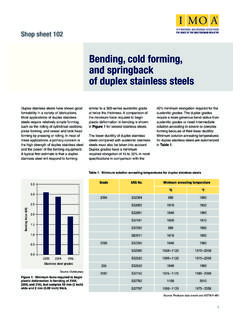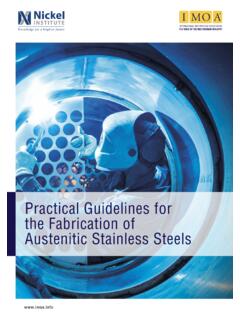Transcription of Melting glass with molybdenum - imoa.info
1 1 Excerpt from MolyReview 2/2013We prize glass because of its clarity and beauty, and also for its immense versatility. molybdenum componentshelp to make the glass and glass products used every day. Moly s high strength at the high glass Melting temperature and its resistance to corrosion by molten glass make it the ideal material for this glass with molybdenumHuman beings use of glass predates historical records, going back to the dayswhen primitive peoples used obsidianglass formed naturally from lava for knivesand cutting implements. In its progressionfrom ancient history to modern times, glass has shown its utility in countless applications and has become indispensibleto everyday life. Today, molybdenum isjust as indispensible to glassmakingArchaeological evidence suggests thatthe first manufactured glass globuleswere formed serendipitously in cookingfires. The early humans who discoveredthese globules probably used them for decoration. Archaeologists think thatthe first intentionally created glass products appeared 3,000 3,500 BCE inMesopotamia (modern Iraq and northernSyria).
2 Early glassmakers could not create enough heat to work their glasseasily, but with the invention of the blowpipe in Babylonia (modern southernIraq) in about 1,500 BCE, glassmakingbecame an important technology. Artisansmade most objects for decorative or utilitarian purposes, but they alwaysdreamed of creating windows from theirmaterials. The Romans attempted tomake windows by flattening globs of hotglass, but the resulting product was toothick and not clear enough to be a was not until the 15thcentury CE that glassmakers in Venice created thefirst clear glass called cristallo , butglass windows remained a luxury because of their cost. The Industrial Revolution greatly increased the ability of manufacturers to melt glass and in1902 Emile Foucalt of Belgium inventedthe sheet glass drawing machine, making mass production of window is introducedWith the advent of electric power, engineers began designing electric furnaces to replace coal or gas fueledfurnaces traditionally used to melt design attempts relied on electricarcs and radiation to heat the glass , but the technologies did not find wide acceptance.
3 In the 1950s, researchersdiscovered that molten glass conductselectricity, and that molybdenum metalelectrodes could heat glass directly by passing electric current through themolten glass bath. molybdenum electrodes began to be used to boost thepower and production of conventionalfossil-fired furnaces. All electric furnacesusing molybdenum electrodes soon followed. Advanced furnace designsIncreased use of electric furnaces inmodern glassmaking has also increasedthe use of molybdenum . Advances have been largely related to electrodedesign. Side-entry and bottom-entry designs are used, as well as electrodessuspended into the glass tank fromabove. molybdenum stirrers help to homogenize the melt. The molten glassbath protects these molybdenum components from the rapid oxidation that would occur at that temperature inair, so that they provide long and reliablelife. Designers use inert cooling gases or water cooling to protect the portion of the electrode outside the glass bathfrom components also protectfurnace refractories from wear and erosion as armor covering the refractorybrick in vulnerable areas.
4 Advanced coatings allow these components to resistoxidation even when being brought totemperature on a cold start with no moltenglass to protect is always competitionFew other materials can match molybdenum for the job. Platinum headsthe list of molybdenum s competitors. It is ideal as a glass electrode in manyaspects, but it is very soft and very expensive! It is used only where nothingelse will do, often as a cladding materialon molybdenum components like oxide has limited use because it is fragile. It is found in small furnaces andin furnaces Melting glass compositionsthat are oxidizing to molybdenum . Carbonis another candidate but it is also fragileand can support only low current A glass head thought to be of King Amenhotep II,dating to about 1,500 BCE. Corning Museum of glass 2 Excerpt from MolyReview 2/2013 The New Beijing Poly Plaza has one of the largest cable-net glass curtainwalls in the world. It allows a clear view of the surrounding that require large electrodes; it suffers from oxidation problems of itsown.
5 Sometimes nickel alloys like Inconel are used but they suffer from lowstrength at temperatures above 1200 C(the most common glass , soda-limeglass, melts in the range of 1500 C),and the electrodes sag and droop duringuse. molybdenum is the material of choice for electric and electric-boost fossil-firedfurnaces. It is strong and sag resistant attemperature, resistant to thermal shock,chemically compatible with a wide arrayof glass compositions, and resistant tocorrosion and erosion. These advantagesmake molybdenum the hands-down winner for electric Melting when viewedfrom the standpoint of total-life cost, even though it is initially more expensivethan all the alternatives except glass is an important part of our worldGlass made with molybdenum electrodesis part of everyday life. It is used for mirrors, the windows that brighten homesand workplaces and provide safety incars, glass bottles and the ubiquitous flat-panel displays of televisions, computers,tablets and mobile phones.
6 glass is even used for the optical fibers that support high-speed internet networks,and the panels critical to efficient solarpower generation. All of the technologiesabove and many more are enabled byglass products made with the help ofmolybdenum glass - Melting electrodes.(John Shields) glass furnaces often use the bottom-entry electrodes, shown as vertical blue components in this cut-away view. The open-top design uses the insulating properties of the raw material to improve thermal efficiency. Toledo Engineering Company, author expresses his gratitude to Mike Friess,Senior Director, Project Management and Brian Naveken, Design Engineer at Toledo Engineering discussions regarding electric furnace design philosophy and material choices.











